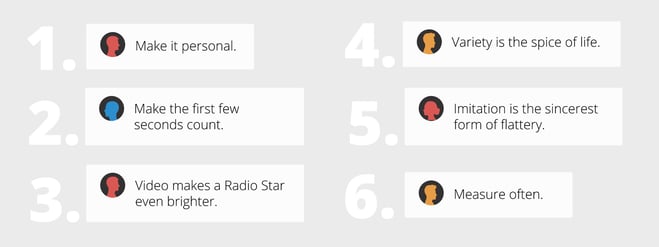6 Ways Champions Create Digital Rapport to Drive Growth
The connection between Rapport and Growth
Champions – people who help other people grow – work hard to build deep rapport with the people they help grow. That’s because Champions know trust and open communication are the foundation of deep relationships. Growth is nourished in the context of deeper relationships.
As relationships are increasingly formed and maintained online, Champions need to make sure their online skills match their offline expertise.
“When you have a rapport with someone, you're better placed to influence, learn and teach. As you build trust people are more likely to accept your ideas, to share information, and to create opportunities together.” MindTools
In this blog you’ll:
- Get a review of the fundamentals
- See ways you can apply those fundamentals to the online world
- Learn the unique opportunities of digital to establish strong connections
- See common mistakes to avoid

In the Real World
Offline or online, the fundamentals are the same. Take a moment to review the basics of, before you see how you can apply those principles to your online interactions.
- First impressions count. First impressions are formed in the blink of an eye. Even more impressive is that first impressions rarely change as the relationship develops. That means how we are perceived from the first moment can have a long term impact on how much we’re trusted.
- Walk a mile in their shoes. Empathy is the ability to see things from another’s perspective. When we take an empathetic approach it tells the other person that we care about them as an individual and encourages trust.
- Make it personal. Dale Carnegie, author of the famous book, How to Win Friends and Influence People famously stated that, “A person’s name, is to him or her the sweetest and most important sound in any language.” When a person hears their name it lets them know that they are important.
- Be the man in the mirror. People like to see themselves reflected in others. Make sure to match the emotions, posture, tone and tempo to the other person.
- Know and be known. People are curious, we want to know. We also want to be known. That means it feels good when other people witness our actions and accept us. Often times the best way to encourage someone to open up is to share a personal detail of your own. As this exchange is repeated, the relationship gains cumulative value.
- Find common ground. It’s natural that we have more trust when we see ourselves in others. That doesn’t mean we want to be copy cats. The key word here is “find.” Take your time to ask questions and uncover shared experiences, hobbies, interests and passions.
The Unique Advantages of Digital
Rapport is a French word that means “to carry back.” In the context of relationships, the word has evolved to mean “what one person sends out, the other sends back.”
This idea that we give and receive is fundamental to online communication and platform models. Just like in the real world, where one person sends out and another sends back, the same is true for online.
An obvious example is a Facebook feed post. When we post to followers (send out) they send back in the form of likes, comments, shares and even new followers. Here are some examples of the unique advantages of technology.
- Connect in the gap. Rapport isn’t permanent. Although it must be established early in a relationship, it must also be reinforced and maintained. Digital technologies and platforms give us the ability to build on-going relationships in the gap between face-to-face sessions.
- Know your people better. A huge part of building relationships is simply knowing the audience. Thanks to in-depth social media profiles and tools that reveal what content people consume, we can know a lot about a person before we ever begin a conversation.
- Measure. Likes, shares, comments follower count, and even sentiment are quantifiable. That makes platforms uniquely positioned to actually measure how well we build connections with others. This helps you know what works and in turn leads to an improved ability to catalyze growth.
6 Ways Champions can Build Digital Rapport

You’ll notice that of the basics, many require in-person and face-to-face communication. The key, online, is to harness those analogue ways and apply them to digital.
1. Make it Personal
In the past, the best way to take a personal approach was to make assumptions and take the time to get to know someone. Now we can know about someone before a first conversation. Because of that ease, people demand a personal approach more than ever. Here’s some basic ways you can make it personal.
- Use a Persona. Personas give you a better understanding of the real goals, values, obstacles, dreams and learning styles of the people you want to reach. This makes it easier to take a tailored approach. Get the full scoop on personas, then download this template you can use to build your own personas you can use to take a custom approach with your people.
- Do your research. Deep social media and online profiles make it easy to know more about the people we want to reach. People reveal a lot of personal details online. This means there is no excuse to not find something interesting or in common.
- Use their name. Just like in face-to-face communication, a person’s name carries a lot of weight online. Most email tools make it easy to personalize messages to recipients.
Pro Tip |
Don’t come across like a stalker. Let the other person know where you learned something. It’s can be as simple as saying “I saw on Facebook that you love to play baseball." |
2. Make the first few seconds count
A strong first impression sets the stage. For many people, their first interactions with someone new are online. While a solid online presence will lead to a good first impression, a dated or incomplete online presence can have a negative effect. Make sure it’s easy for people to:
- Get to know and trust you. Make sure all of your online profiles are up to date. If you don’t think you have the time to maintain 10 different channels, pick the ones where you already have success and start there.
- Get in touch. People are more likely to trust people and their organization when they know they can reach a real person. In fact, 44% of people will leave your site if they don't see any contact info.
- See social proof. Nothing establishes trust like the endorsement of someone your people already respect. Be proud of your work. Ask for and display testimonials prominently on your website and social media channels.
There’s a lot to remember when it comes to first impressions online. To get more details, check out our blog, How to Make a Great Online First Impression.
3. Video makes a Radio Star even brighter
Lack of face time is perhaps the most difficult aspect of digital. Those days are numbered. The year 2017 is already being named the year of video. Video give people a chance to connect with your face and body language.
Did you know? |
79% of people would rather learn from a video than read text on a page. |
4. Variety is the spice of life
Utilize a wide variety of channels to connect with your people, get involved in the conversation, provide praise and encouragement and facilitate growth. Here’s some common ways to join the conversation:
- Feed posts. Most social platforms have a feed. Feed is a place to share with anyone who follows you. Post an image, an inspiring quote, or a question and let people learn about your interests and presence in a way that doesn’t demand a response.
- Direct messages. They allow for natural back and forth. Think of it like a confidential chat or text conversation.
- @Mentions. Most social platforms have this built in feature. You can utilize @mentions to notify your people about relevant content or conversations. It’s the digital equivalent of sending a newspaper clipping in the mail.
- Try different channels. Facebook, Instagram, SnapChat, Gloo, Email, LinkedIn. Every platform has a unique set of guidelines that influence how people interact. And every group of people has a preferred platform. Test out and vary your message across each channel to see what resonates best with your people.
- Vary your tone. Extroverted, introverted, heavily branded or unrefined. There’s an unlimited number of ways to express yourself online. Vary your approach and see how your people responds.
- Vary your approach. Not only are there a lot of platforms to try, but every platform offers a variety of ways to connect. There’s newsfeeds, direct messages, stories, images and character limits just to name a few. Don’t be afraid to try different methods to see what your people respond to best.
5. Imitation is the sincerest form of flattery
Don’t be afraid to borrow from people and organizations that do a great job of building trust online. Here’s a few organizations worth emulatting .
- HubSpot. HubSpot practically defined online rapport. Their number one focus is to provide value to their customers through in-depth content and personalized communication.
- FamilyLife. FamilyLife does an amazing job of blending their online and offline activities. Between radio shows, social media and their mobile application, FamilyLife has mastered the art of online and offline relationship building.
- Southwest Airlines. Southwest Airlines knows how painful air travel can be. That’s why they work so hard to let you know that they’ve got your back.
6. Measure often
There are no hard and fast rules when it comes to human interactions. The best way to uncover what resonates with the unique people that you grow is to experiment. The great news is that because online communication offers unique capabilities to quantify results, it offers tremendous opportunity to measure and test your approach.
Avoid the common mistakes
There are a few things you want to avoid. Follow these tips to come accross more trustworthy, build deeper links with your people.
- Lack of sincerity. People can sniff out insincerity from a mile away. If you do not genuinely care for people you will find yourself without many friends.
- Slow down. Just because online communication is instant, doesn’t mean you need to build a year’s worth of rapport in 6 hours. Take the time to explore the interest of your audience, and make sure to give them the time to explore your online presence.
- There's a time and place for everything. Every social network or online communication tool is designed around the exchange of value. To ensure users are able to easily exchange value, there are written and unwritten expectations for how each is used. What draws a lot of LOLs on SnapChat, probably won’t get you your next job on LinkedIn.
In a nutshell
Rapport lays the foundation for trust and open communication. There are basics that apply to both digital and face-to-face interactions. As the world becomes increasingly digital, it’s critical to make sure your digital skills back up your awesome in- person skills. The great thing is, digital provides some unique opportunities to build, maintain and measure how you connect with the people you grow.
